Day followed day without rain and our rivers were painfully shrunken. On the lower Wye I saw sections of the river bed and details of migratory fish lies which I could not remember viewing before. Salmon occasionally splashed angrily in the deeper pools, unable to move up further. For all the dry weather, there were many cloudy days, the nights were colder now and there was something of autumn in the air. Leaves were already turning colour. The insects seen above and on the surface were the creatures of autumn, small and grey in colour, willow flies and pale watery duns. Grayling were already rising with vigour and, despite the low water, there were some good days to be had on the upper Wye.
On the 3rd BC from Huddersfield fished the Lugg at Lyepole for 4 trout and 3 grayling using a black nymph. He noticed the remains of many crayfish meals on the banks and wondered about mink? Or more likely otters, I would have thought, given the location. PR from Eaglescliffe who fished the Tees is new to the sport and remarked “keeping a dry fly on the surface is harder than it looks.” Indeed it is PR, but I should point out the Greenwells shown in your photograph looks very like the wet version to me. It should go very well on the tail fly with a couple of spiders on the droppers, always given a decent flow of water in the river.
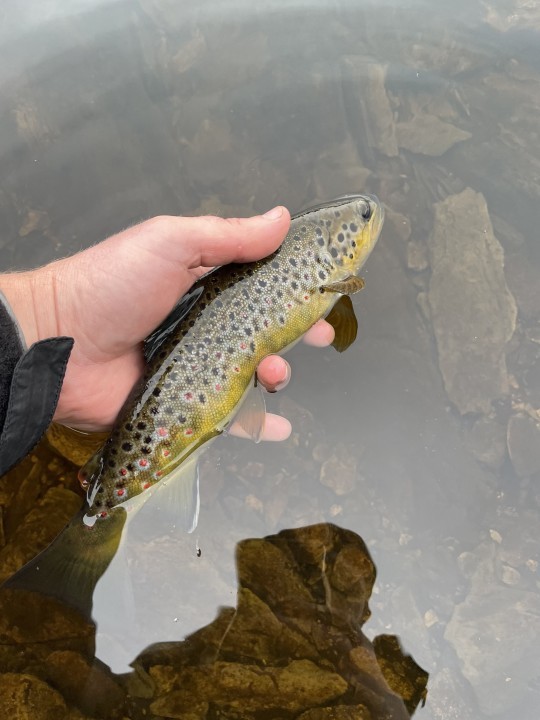 Gammallt trout - LH from Wrenbury
Gammallt trout - LH from Wrenbury  Low water on the Arrow - JA from Leominster
Low water on the Arrow - JA from Leominster 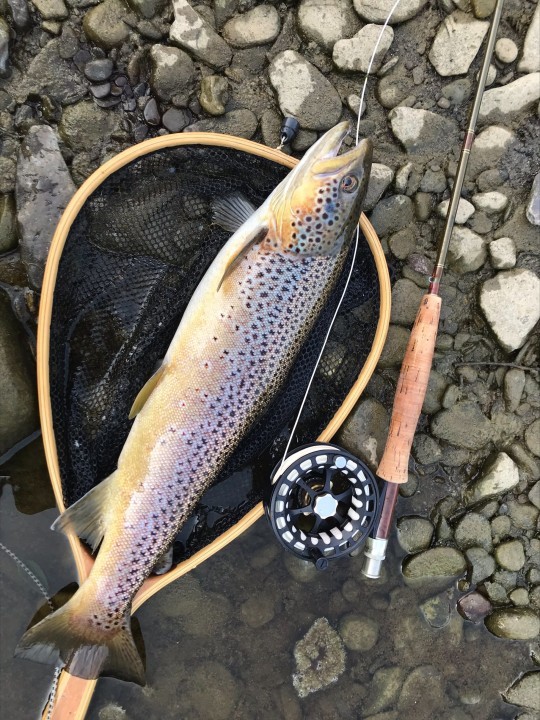 21 inch trout from the upper Wye - AM from Dorridge
21 inch trout from the upper Wye - AM from Dorridge SS from Solihull had his fishing spoiled by a trespassing canoeist scraping over the rocks of the Usk at Ashford House: “I asked him what he was thinking but…he didn’t respond particularly well.” I can imagine. Canoe trespassing on both rivers is now almost a daily occurrence. On the 5th DS from Luton with a friend took 2 trout and 18 grayling on dries from the upper part of the Rectory. AM from Dorridge fished at Abernant with a Klinkhammer and caught 18 grayling and a single specimen trout of 21 inches. It certainly looks like a wild one to me, AM, (photo above right) and I am not aware of any stocking carried out to this part of the Wye in recent years. I will recall one of my old stories about this beat if I can be allowed. This involved a trout which I was playing into the net which was first attacked and then grabbed by a larger one. Unfortunately the predator let go just short of the net, but not before I had a good look at a very large hen brownie. The lucky-to-survive smaller trout I had hooked, and which was eventually netted and released with scarred flanks, was 13 inches long. Imagine, if you will, a trout big enough to eat another of 13 inches. I never saw the attacker again.
CT from Cardiff with a friend reported 14 trout from the Cambrian AA’s Llynau Gamalt, taken during a fall of red ants. IG from Pontypridd was so concerned about the shrunken state of the Honddu at Lower Stanton that, with fish welfare in mind, he decided not to fish. Meanwhile AU from Worcester reported two groups of poachers (including children) fishing the Cannop Brook with bait. The silly season was obviously in full flow even if the stream was not. AU was obviously slightly depressed about this encounter, so may I ask if anything was said or done about it at the time?
JH from Lichfield reported spawning carp at Stockley Pond, which seems extraordinarily late, but the event is pretty much unmistakable. I once watched some very large carp spawning in a weedy bay of Surrey’s Frensham Pond and it was a rough affair indeed, rather like a dog fight. On the 6th JA from Leominster fished at Hundred House, where there are deep pools at the top of the Edw, and caught 9 trout on dry flies. JA from Craven Arms with a friend fished the Wesh Dee at Llangollen and caught 3 trout and 11 grayling on nymphs. JH from Chepstow used a small F-Fly and a little black Klinkhammer to take 13 grayling at Doldowlod. The bag included a specimen hen grayling of 19 inches. MD from Cardiff with a friend were fishing at the Rocks, where they took 3 trout and 8 grayling, despite the efforts of a trespassing canoeist who deliberately smacked the surface with the flat of his paddle when hailed about the broken agreement. I’m afraid that is the way of it these days; aggressive canoeists and indeed cyclists seem to care only about themselves when accessing our countryside.
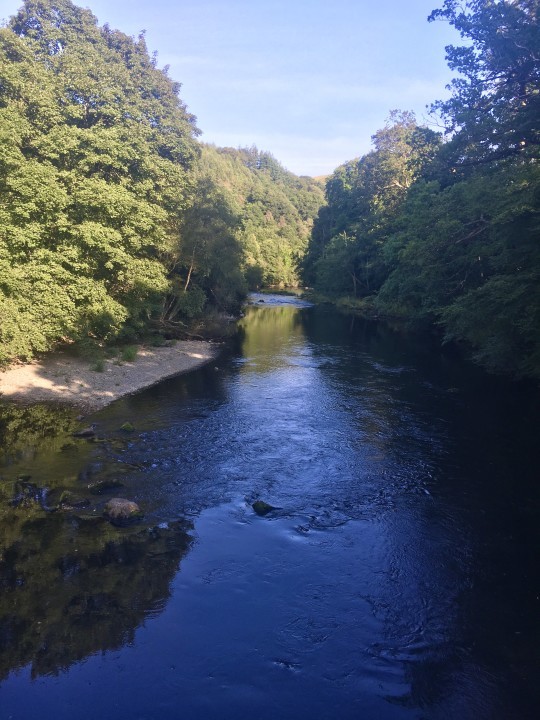 Doldowlod - JH from Chepstow
Doldowlod - JH from Chepstow 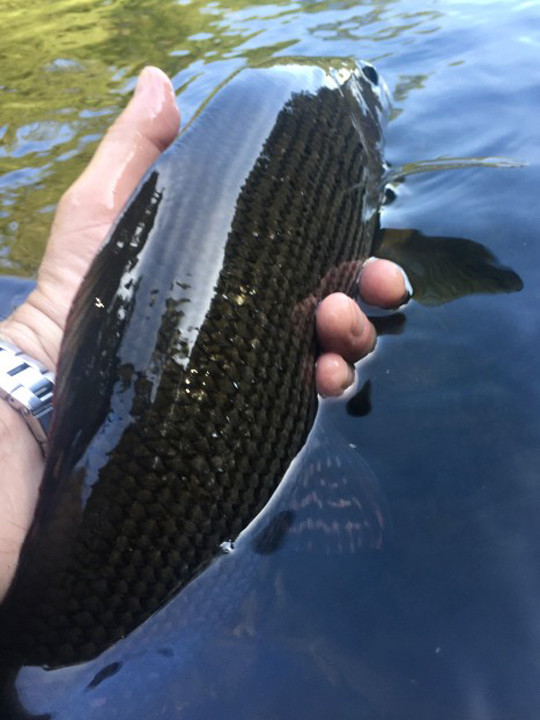 19 inch grayling - JH from Chepstow
19 inch grayling - JH from Chepstow  Craig Llyn grayling - GBS from Brecon
Craig Llyn grayling - GBS from Brecon Rather unexpectedly, at this point the change to autumnal weather suddenly went into reverse and we experienced a clammy and rather uncomfortable heat wave. On the 7th we recorded an air temperature of 30 degrees and some parts of Britain had their hottest September day in a century. We seem to be breaking weather records on such a regular basis now that it seems hard to believe that just a few years back there were those who didn’t believe in climate change. The fishing under glaring skies was consequently poor although JA from Craven Arms, on Lower Glanwye now, was able to take 15 trout and 2 grayling by tight line nymphing. This was in the run by the island at the bottom of the beat. As JA remarked, access to upper part is difficult as there is hardly any room between the river and the road above. To get to the top, you really need to know your way up and down the bank and through the rocks.
After a couple of days the hot weather broke up in showers, which were heavy in places and for short periods, but the rivers moved barely an inch as the thirsty ground and the trees sucked up the water. On the 8th JS from Oxted found few rises at Ty Newydd, but managed 15 grayling to nymphs. The following day NG from Dilwyn fished the gutters at Doldowlod, taking 6 trout to a pound and 12 grayling to 2 pounds on both dries and nymphs. NT from Childs Ercall was up on the Dee at Llangollen Maelor, where he accounted for 12 trout and 4 grayling. JA from Leominster fished the little Edw at Hergest, where he caught 13 trout to 12 inches on a small Parachute Greenwells and Tan Klinkhammer. On the 11th JM from Salcombe had 12 grayling at Abernant, while on Llwyn Reservoir AP from Pontygwith took 6 trout in quick succession using a Black and Peacock spider on the point. He thought a shoal must have been passing. AK from Blakeney fished Gromaine and Upper Llanstephan on the 12th, taking 5 trout and 15 grayling to 12 inches, mostly on emergers.
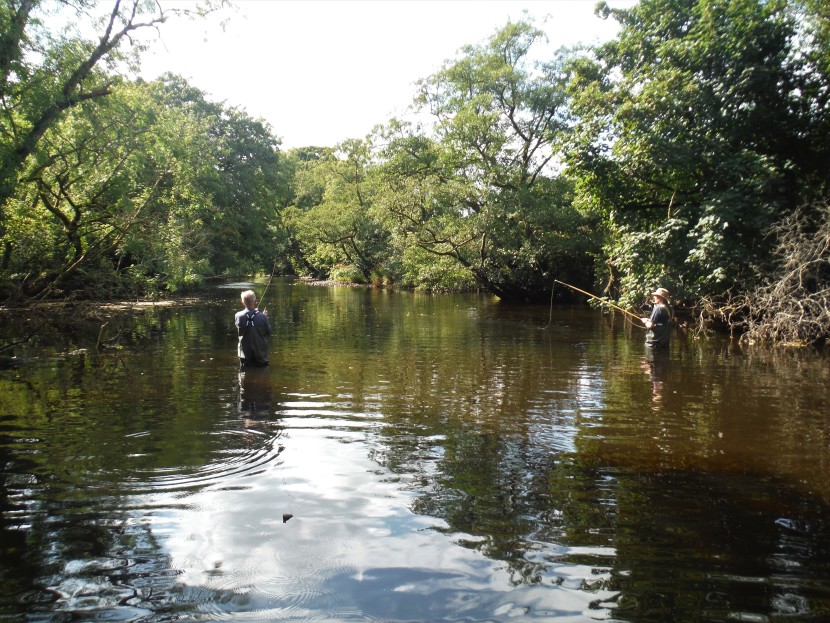 Cammarch Hotel middle beat
Cammarch Hotel middle beat 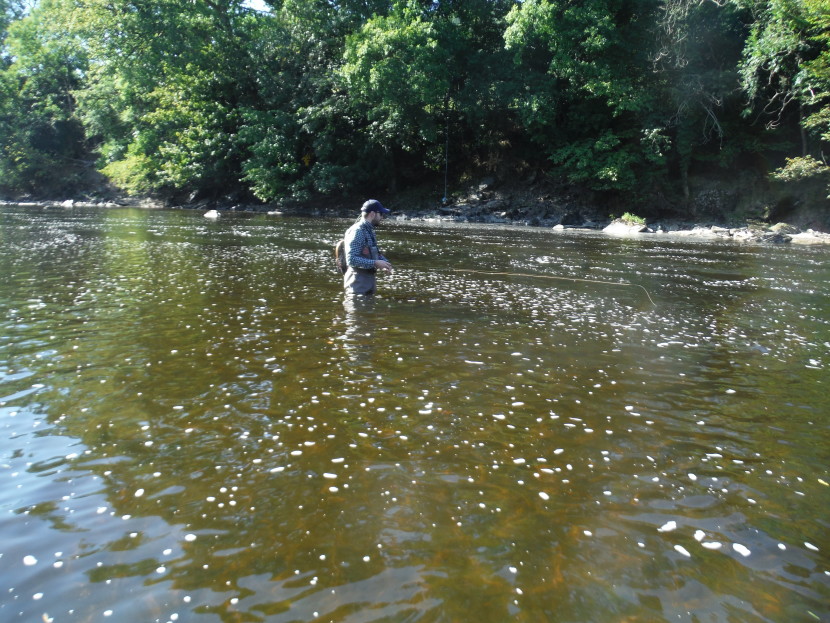 And quietly flows the Wye!
And quietly flows the Wye! 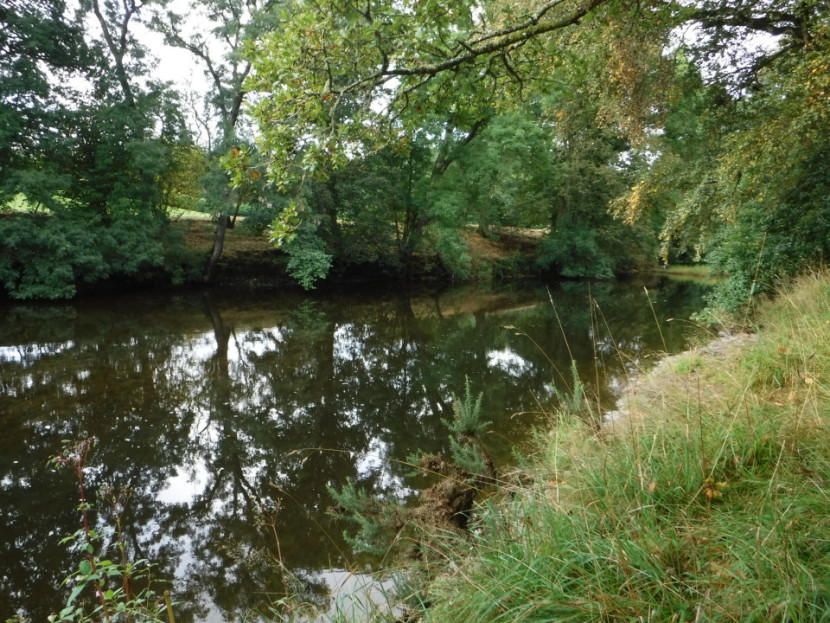 Aberbwtran - BP from Pembridge
Aberbwtran - BP from Pembridge 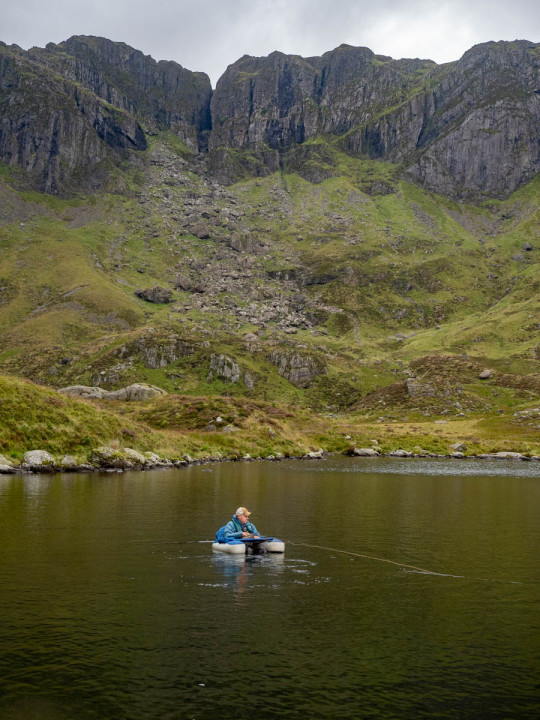 Float tubing on Llyn Idwal - CT from Cardiff
Float tubing on Llyn Idwal - CT from Cardiff AM from Dorridge had a remark to make about a couple of surprise chub which turned up during his grayling day at Llangoed and Lower Llanstephan: “I have nothing against chub, and spent a lot of my youth trying to catch them, but not what I got out of a warm bed at 5.30 this morning for.” I know what he means; chub have that unfortunate habit of being the slightly disappointing by-catch when different fish are looked for. The line tightens as you fish a big tube fly round the tail of a salmon pool on a sink tip; excitement for a second, but then: “Oh no, just a chub.” The swim goes quiet as you trot for mid-winter grayling, but then the float goes down and here comes a big logger-headed chub which has barged its way in and pushed the gentler grayling aside.
Lower Wye coarse fishers are usually after barbel if truth be told, but chub is very often what they get, and sometimes more of them than they would wish for. Poor old chub always seem to be designated as second-best. This seems a shame; if I remember right a Thames chub on cheese paste trotted down from a moored skiff was the first decent sized fish I ever caught and I can remember as a boy climbing trees leaning over deep pools on the Surrey Wey and looking down at the great grey shapes below. You could get them to take darts of fox tail grass dropped to the surface and they would hold on for a couple of seconds before spitting them out. Once on the lower Wye I remember looking down from a high bank at a shoal of huge chub, some of them 6 pounds or more, gathered together during a sedge hatch and wondering how I could get at them. AB from Nottingham fished at Foy Bridge, spotted some chub under bushes and free-lined floating crust to them: “…first cast got a chub of about 5 pounds a rod length out. Great fight on a 14ft float rod.” Sometimes the simplest fishing ideas are the best.
CM from Braintree took 1 trout and 10 grayling at Lyepole on the 14th, while on the 15th NH from Lydney took a salmon at Courtfield while trotting bread flake downstream for chub. I can imagine that frustrated salmon anglers reading that report will let out a long sigh of exasperation. I can’t comment beyond the oft-repeated remark that you can never quite tell what a salmon will do. CT from Cardiff with two friends had an interesting time fishing Llyn Cwellyn and other mountain tarns belonging to the SGLL Fishing Society. They had 18 pretty golden trout between 8-11 inches, but noted the need to pay 6 pounds for a day parking ticket for this remote area. There does seem to be a tendency these days to gouge unfortunate visitors just looking for a day in open countryside. (If you wish to enjoy a contrasting experience, try fishing the Usk Town Water and while you are doing so park for free in the town car park. They actually like having visitors there. You do have to pay for your fishing ticket at Sweets Tackle Shop).
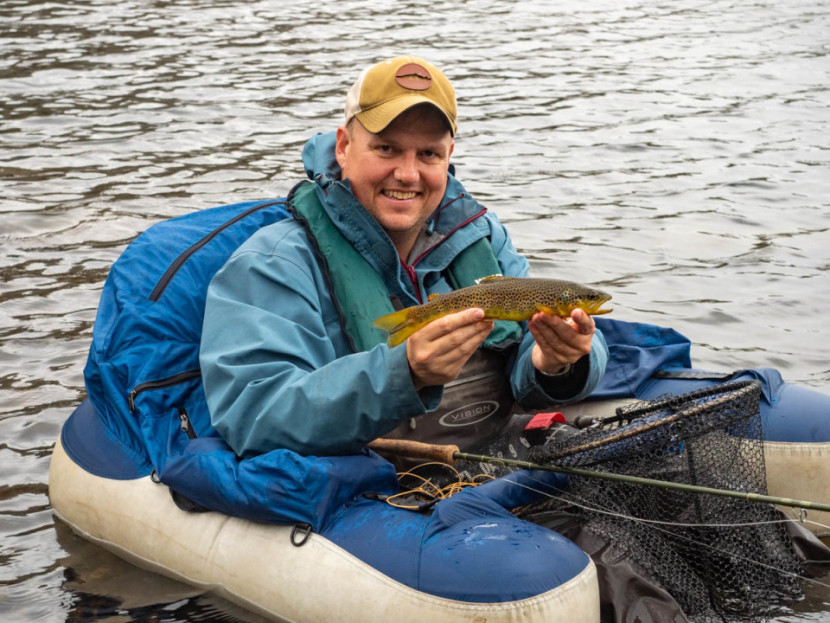 And a result! CT from Cardiff
And a result! CT from Cardiff  Colours of Bideford trout
Colours of Bideford trout 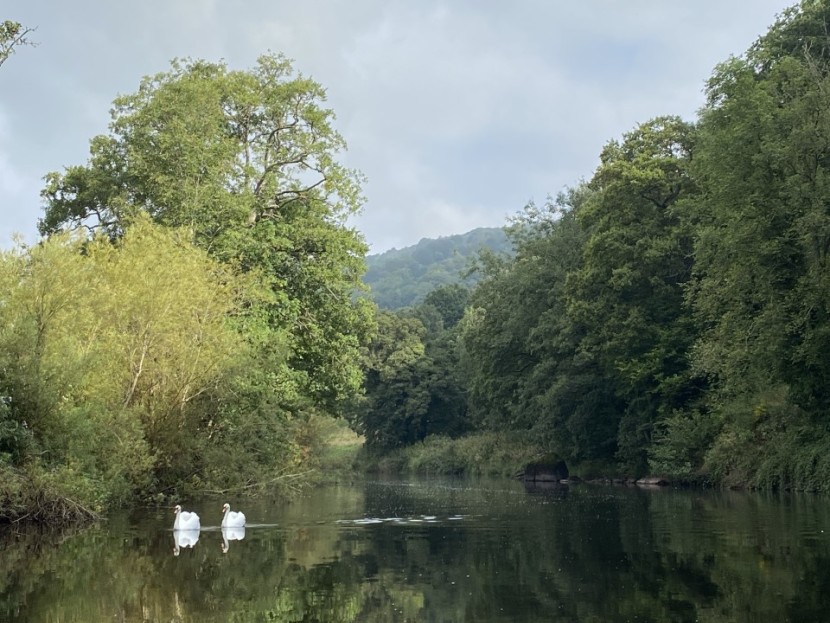 Ashford House - PD from Cheltenham
Ashford House - PD from Cheltenham Meanwhile, nights were getting cooler again and we experienced heavy dews and some foggy mornings. Although the main rivers were as low as ever, the appetites of grayling were sharpening. Provided midday sunshine was not too strong we were taking rising grayling to size 16 patterns like John Storey, Red Tag and Grayling Steel Blue. Some more modern flies like Duck’s Dun and Griffith’s Gnat held their own. One warm afternoon on the Usk near Brecon, I watched trout moving to a hatch of August duns. This is a bit like the March brown all over again, only at the end of the season rather than the beginning. On the 23rd MM from Petersfield recorded a trout of 2 pounds in a catch of 4 made on the Irfon at Cefnllysgwynne. He had been after grayling with small dry flies.
DD from Blakeney drove 112 miles the following day to fish Llyn Egnant, catching a brown trout of 1.5 pounds on what I think must have been a Ke-He. That is a wet fly pattern from the Orkneys and, according to Stan Headley, was invented by a Mr Kemp and a Mr Heddle. MH from Swansea had a very large catch of small trout and grayling from Gromaine and Lower Llanstephan, using for some reason a 7 foot 3 weight brook rod. IC from Gloucestershire fished at Doldowlod the following day, catching a trout of 15 inches and a grayling of 17 inches in a bag of 7. DM from Swansea fished the Irfon at Llanfechan, for 8 trout to 1 pound and 3 grayling, all on CDC dry flies. On the 26th N from S Wales with a friend had 14 trout from Llyn Egnant. I note that AG from Taunton with a friend had no less than 86 barbel between them, mostly small ones, along with 11 chub from the fast water at Wyebank. That is a wonderful stretch for trotting a float. Personally, I have an ambition to get a grilse from it on some lucky mid-summer day, maybe early morning before the canoes arrive.
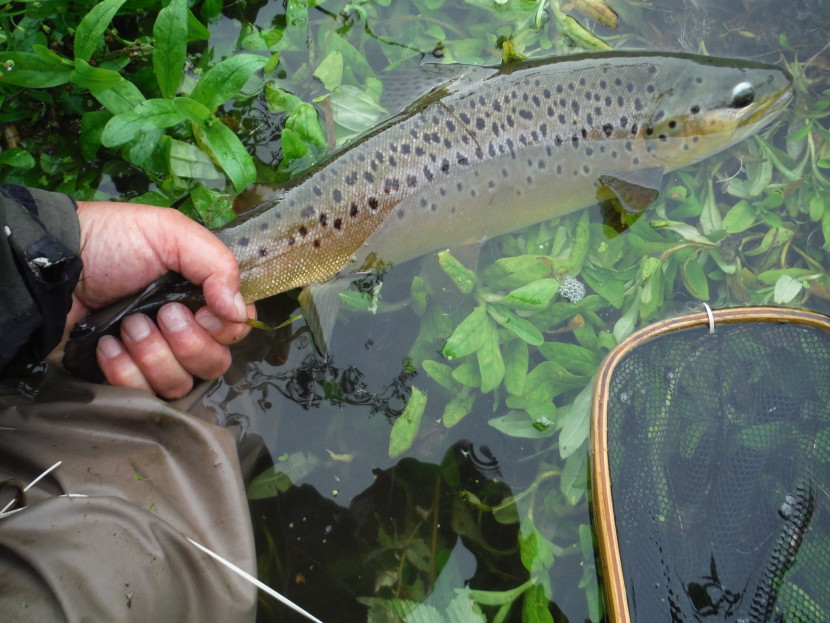 Season's end
Season's end  Low water on Bideford Brook
Low water on Bideford Brook  Edw Hergest beat - JA from Leominster
Edw Hergest beat - JA from Leominster This was where the drought finally ended. Heavy rain before dawn on the 27th got some of the tributaries rising, but some real rain followed on the 28th. First the Usk, then the Wye rose up into proper dirty flood. AG from Harleston (who comes over from Norfolk every year and sleeps in his car) watched a rising river at Dolgau on the 27th, but managed 4 trout and 2 grayling. On the following day at Ty Newydd the muddy waters defeated his efforts and he left at midday. After an hour of heavy rain, RM from Leatherhead took a 15 pounds cock salmon from Goodrich Court’s Vanstone Pool. LD from Hereford had a 34 inch hen salmon on a Gold-bodied Willie Gunn tube at the Rectory on the 30th as the river rose, while AH from Oxford reported a rare sea trout from the Usk at Chainbridge.
So we came to the end of the 2021 trout season, in what has been a quite unusual year. Personally I fished less than I can remember for a very long time. Much of the spring was wasted due to the pandemic lockdown restrictions, particularly the restrictions on crossing the Welsh border. Consequently I hardly managed to fish my association Usk beats and missed all the famous early spring Usk hatches. And guiding this year has been exceptionally busy when we finally got started, although I don’t mean to complain about that. Despite the drought there was a huge interest in trout fishing on our rivers, often from people who had never fly-fished before. That at least was encouraging. Salmon fishing opportunities on the other hand were few. I had the impression that many of our tributaries in the Wild Streams scheme were fished less than usual.
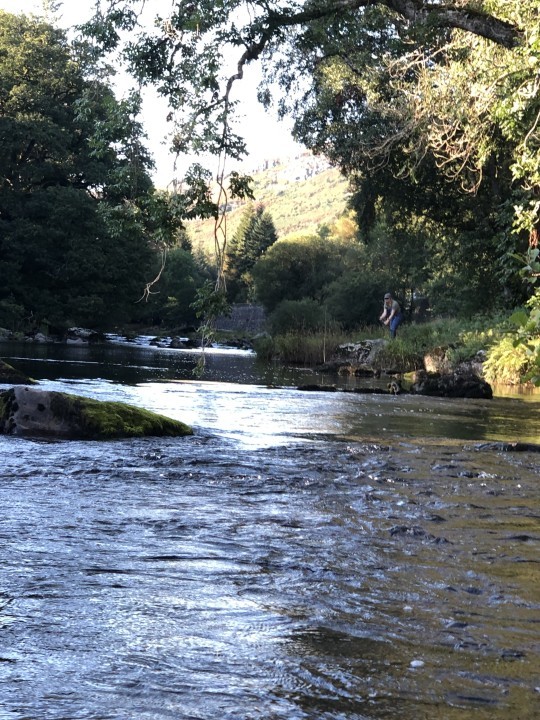 Dolgau - ST from Farnham
Dolgau - ST from Farnham 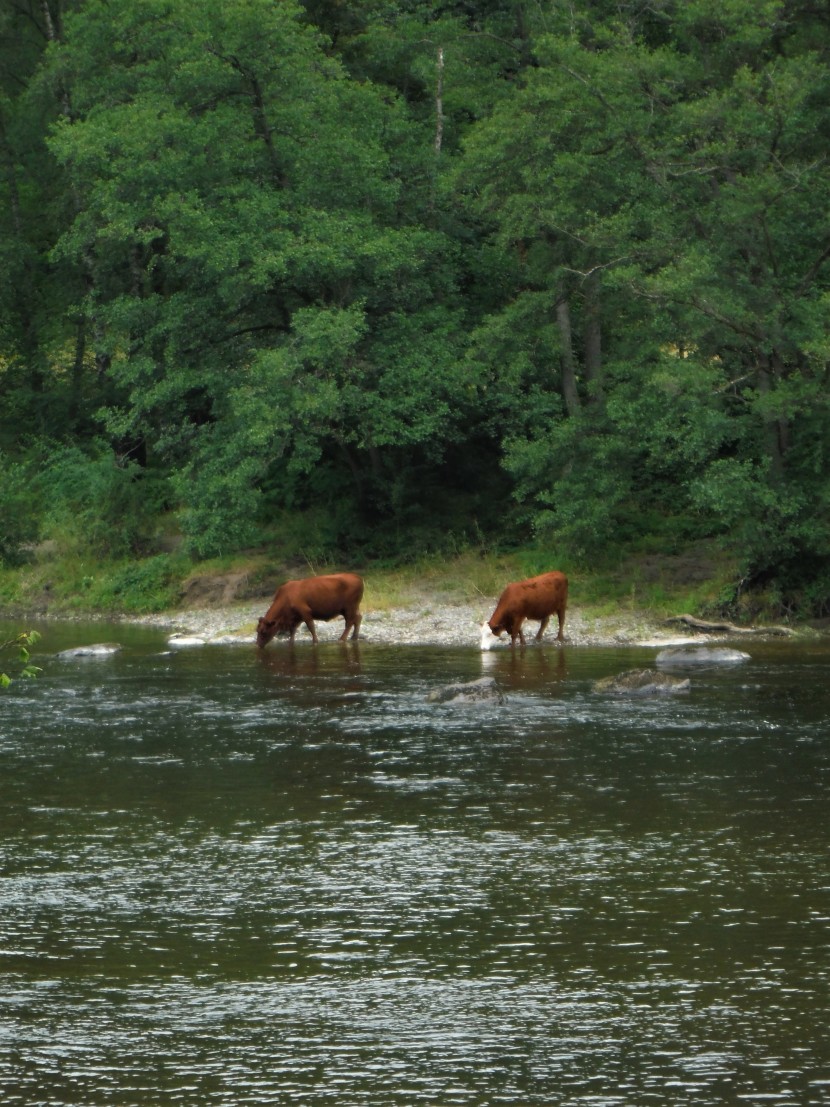 Ty Newydd cattle
Ty Newydd cattle 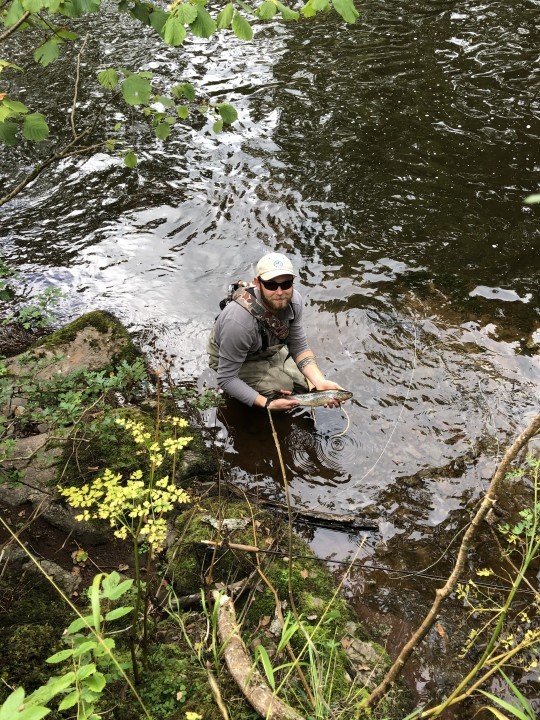 Pantyscallog trout - ST from Farnham
Pantyscallog trout - ST from Farnham I do have some interesting memories from 2021 though: in particular, a couple of good fish taken with the dry fly on the Monnow. Also fishing the Upper Avon at Heale on a warm afternoon with big trout sipping mayfly spinners from the surface as a slow current went gliding downstream. The problem was that the fish, normally on station, were actively on the move, so where exactly to drop the artificial? I managed a few with some effort, while remaining crouched down in the bankside vegetation. David Burren usually sits in the sedges with his feet in the water and waits for them in comfort. Frederic Halford, rather full of himself, had something to say about this situation in An Angler’s Autobiography:
“In one of the carriers we saw the head of a huge trout come up and take a spent gnat. I was on my knees in a moment, crawled up in position and waited for the next rise. This is always a good policy when trout are on spent gnat, as they invariably travel and are dreadfully shy. Up it came again four or five yards further up, a good underhanded cast landed the fly right at the first attempt, and the fish came with a flop which set my heart beating.”
The surprising thing about mayfly at Heale is that the hatch on the Avon continues to some extent right to the end of the season. David told me the other day about a 19 inch grayling, a very good fish anywhere, which made a little sip to a new-hatched mayfly floating along under the far bank just off the line of sedges. He eventually got it with a small Grey Wulff.
After that encouraging report on the Bideford Brook following the EA’s electro-fishing last month, I’m afraid we have now had some bad news about the same system. We have known for some time that the Blackpool, Cinderford and Soudley brooks, which drain several valleys of the eastern part of the Dean forest before breaking through the hills and combining together in the Bideford Brook which runs down to the Severn, together form supposedly one of the last refuges of native white-clawed crayfish. The catchment includes a small tributary running from Little Dean into the Soudley Valley and feeding four artificial lakes, one of which is the “Forest Pool” which I have so often written about with its rainbow trout fishing. It is generally known that the specific risk associated with the invading American signal crayfish is that it carries a crayfish plague spread by fungal spores. While the American species is relatively resistant to the plague, the disease is likely to cause a total wipe-out when it reaches the native British population in any given stream. The Soudley system was the last one in the Dean to remain free of American signals and the plague they carry; the Cannop Brook in the neighbouring valley was invaded and infected some five years ago.
.JPG?w=830) Our native white clawed crayfish
Our native white clawed crayfish 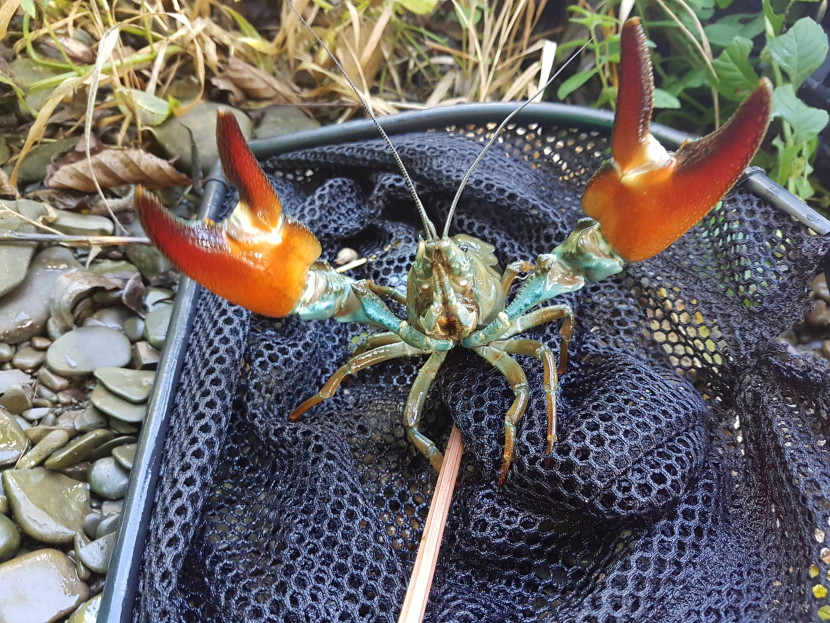 The invasive American signal crayfish, this one from the Lugg
The invasive American signal crayfish, this one from the Lugg Our syndicate and other fishing associations in the Dean have been aware of the risk for some time. Crayfish eggs might be carried along with the water supplied with stock fish, on fishing tackle or waders, or in wet animal fur or on the legs of water birds. Accordingly, for a long time stock trout have been transported in from Exmoor, a non-infected area, although there are closer suppliers in the Cotswolds on streams linked to the upper waters of the Thames (which was one of the first British systems to be infected). Fishing tackle has been disinfected or reserved for use in just the one location. However, despite various warning notices it hasn’t proved possible to persuade walkers not to swim their dogs, while of course boar and deer drink at the pool, and naturally enough water birds will fly where they will. Meanwhile and further down the system, the WUF has advised anglers to be careful not to become unwitting carriers and especially to avoid fishing first an infected stream like Cannop, followed by Bideford or Blackpool brooks on the same day.
It seemed almost inevitable that the defences would be breached sooner or later, despite best efforts made. Dead white clawed crayfish were found in numbers on the upper part of the Soudley Brook at the end of August and the corpses were sent to CEFAS for investigation. The plague has now been confirmed and seems to be spreading upstream, with new corpses being found in the upper pools. Meanwhile the EA will investigate the suspected presence of American signals. Dean anglers have been advised to stop fishing for the moment, particularly when there is likely to be a peak of released plague spores in the water. We have learned that this disease, rather like Covid 19, has its peaks and troughs. After all we are all amateur epidemiologists these days. Nobody has ever, to my knowledge, managed to eliminate American signals once they have gained a hold on a water course, so that is likely to be the end of the affair.
Along with some of my neighbours, I find it hard to understand why the Forest of Dean has never been designated as an Area of Outstanding Natural Beauty. Natural England has just completed a review and several areas have been promoted to the greater levels of protection which AONB status gives. However, this does not include the Royal Forest, which clearly is a most beautiful place with its tree-covered hills and deep valleys, and unique now in the UK with more than 20,000 acres of ancient woodland still remaining. Drive up from the Wye valley (itself an AONB) from Bigsweir to St Briavels or from Monmouth to Staunton and you will rise from one beautiful landscape to another one, slightly different again. There are in fact several places where the thick mass of trees crosses the river and starts to invade Wales. The wide Forest bowl, with its giant oaks, bluebell woods and local playwright Dennis Potter’s “blue remembered hills,” not to mention the secretive ponds and streams, is undeniably a magnificent place. On the other hand and to be fair, some of the villages are not so photogenic. They look, in fact, like what they originally were: pit villages for the miners who worked here. And of course the industrial heritage is interesting in itself.
The slightly grimy appearance, even today, of some Forest villages may lend a clue to the reluctance to grant AONB status. Dean was listed as Britain’s first National Forest Park in 1938, although this designation, as far as I can see, does not confer any particularly useful protection against unsympathetic development. Since then, its status was reconsidered in 1959 and 1971. On these occasions, the National Coal Board made objections as it was still seen as a site for further mineral abstraction. Local councillors were also very much influenced by the schedule of pit closures and widespread unemployment. Following an attempt to open large scale open-cast mining as recently as 1996, the Countryside Commission was asked to look at the status of the Forest and produced a report recommending enhanced protection through AONB designation. It was never acted upon. More recently still the Forest dome was suggested as an area for experimental fracking, to which those of us concerned with the purity of its springs and streams objected naturally enough. Housing development, relatively unrestricted by any conservation status, is now proceeding at a startling speed, and there seems a government determination to turn our small country towns into large country towns. Most of the building is on green field rather than brown field sites. And yet ever since the closure of heavy industry more than 50 years ago, this has been an area already housing a large population, but with few new employment opportunities. Compared to the Cotswolds, for example, the Forest is a crowded place.
All through this period the number of tourist visits to the Forest has been increasing steadily and the whole area has been moving in the direction of conservation and outdoor leisure activities. More than half the population now have arrived from other parts of the UK. Believe it or not, even more traditional foresters have recognised that the future for them lies, possibly in selling ice creams and renting mountain bikes to visitors, but certainly not in coal mines or foundries! Every summer weekend the woods and paths are full of walkers with the accents of the midlands and further afield. Accordingly, it seems very disappointing that Natural England has missed this opportunity during its recent review, favouring instead AONB extensions in the Surrey Hills, Chilterns, Yorkshire Wolds and Cheshire.
Finally a footnote to the piece last month about the fall of Afghanistan. The main resistance in the Panjshir valley has collapsed. Ahmed Massoud is said to be in France, his military deputy in Tajikistan. I suppose that without international support that was inevitable. Last week, while the new Taliban government demanded to address the United Nations, and while the nations of the world agonized about whether the new administration, which is almost entirely male and Pashtun, should be recognized or not, a battered pickup truck visited, one after the other, the four main squares in Herat city. By arrangement, a motor crane was waiting in each square. The bloodied bodies of four alleged criminals, accused by Taliban police of an armed kidnap attempt, were each of them hoisted up to be left swinging as a public example. So I think we can see how it’s going to go with the Taliban this time round. China and Pakistan are pressing to recognise the new Taliban regime, but other UN member states probably will not and certainly should not. The US has already passed legislation to allow aid funding to continue direct to Afghan beneficiaries via the UN and NGOs – as previously. However, if I were an Afghan today, I could think of nothing beyond how to get myself and my family out of the country. There is nothing much more we can do about it now, so I will try to remember happier times. Meanwhile I can carry on worrying about more domestic matters such as whether or not the government is going to trigger Article 16 and return Northern Ireland into the United Kingdom and was the media scare-mongering which created a run on the petrol stations this month deliberate, or merely stupid?
Better go fishing, so press on with the grayling.
Oliver Burch